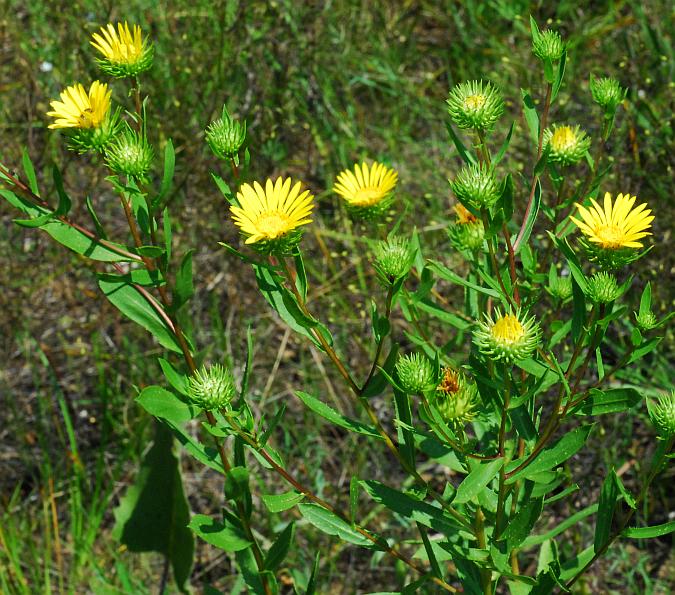Grindelia lanceolata Nutt.
Spiny-Toothed Gumweed

Native
CC = 3
CW = 5
MOC = 39
© SRTurner
Grindelia lanceolata Nutt.Spiny-Toothed Gumweed | |
 |
Native CC = 3 CW = 5 MOC = 39 |
© SRTurner |
|
Family - Asteraceae/Astereae Habit - Taprooted biennial or perennial forb, flowering only once before dying. Stems - Erect, to 1.5 m, branching above, glabrous, often reddish.
Leaves - Alternate, simple, sessile. Blades 2-11 cm long, linear to lanceolate-oblong, angled to rounded or occasionally nearly truncate at the base and slightly clasping to moderately sheathing the stem, tapered to a sharply pointed tip, the margins with sparse to moderate sharp teeth, or less commonly some of the leaves entire, the teeth mostly with a minute, bristlelike extension at the tip, the surfaces appearing not or only slightly resinous, with moderate to dense glandular dots, but these inconspicuous and only slightly differing in color from the surrounding leaf tissue. Margins between teeth setulose.
Inflorescence - Solitary heads or loose clusters at branch tips. Heads - Radiate, short-stalked, with a few short, leaflike, linear bracts which grade into the involucral bracts. Receptacle nearly flat, 1.5-2.0 cm in diameter. Involucre 10-20 mm long, the bracts in 4-6 subequal series, loosely imbricate, linear-attenuate, glabrous, viscid, loosely ascending to slightly curved outward.
Flowers - Ray florets 14-30, pistillate, the corolla 8-16 mm long, yellow, glabrous. Disc florets perfect or some of the inner and/or outer ones functionally staminate, the corollas 4.0-7.5 mm long, yellow, viscid. Pappus of 2 slender awns, 4-8 mm long, these not barbed, not fused at the base, not persistent at fruiting (usually shed individually as the fruit matures), off-white to straw-colored. Stamens 5, adnate to base of corolla tube. Filaments very short. Anthers to 3 mm long, included, connate around style. Style bifurcate. Stigmas pubescent.
Fruits - Achenes 3-6 mm long, straw-colored to light gray. Flowering - August - October. Habitat - Glades, upland prairies, upland forest openings, pastures, fields, railroads, roadsides; often on calcareous substrates. Origin - Native to the U.S. Lookalikes - None close. Other info. - This species of Grindelia is found in scattered counties across Missouri, somewhat less commonly north of the Missouri River. Its distribution beyond Missouri is not extensive, being mainly limited to a few states to the south and west. The plant is easily recognized by its sticky, spiny involucres on yellow flowering heads. The small, spiny teeth on the leaves are also distinctive, though plants are occasionally found in which these are absent. Photographs taken at the Pea Ridge National Military Park, Rodgers, AR., 8-11-03 (DETenaglia); also at Shaw Nature Reserve, Franklin County, MO, 8-11-2006, 8-29-2008, and 10-11-2010, St. Joe State Park, St. Francois County, MO, 9-12-2012, Victoria Glade, Jefferson County, MO, 8-28-2016, Little Lost Creek Conservation Area, Warren County, MO, 8-23-2017, and Glade Top Trail National Scenic Byway, Ozark County, MO, 8-15-2023 (SRTurner). |